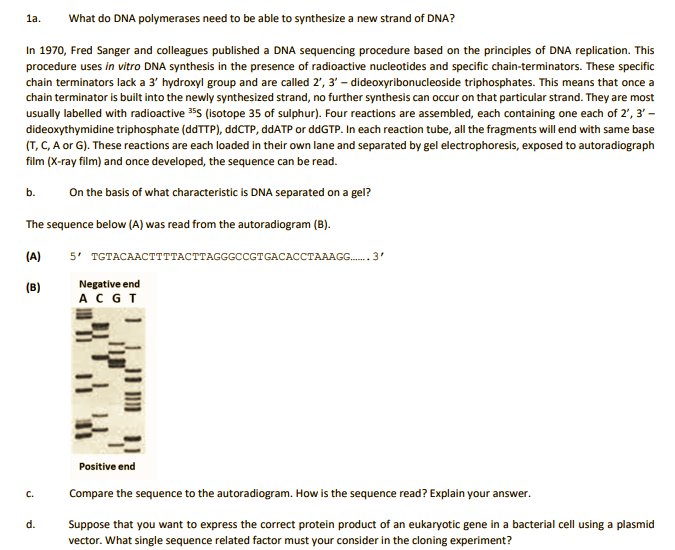1a. What do DNA polymerases need to be able to synthesize a new strand of DNA? In 1970, Fred Sanger and colleagues published a DNA sequencing procedure based on the principles of DNA replication. This procedure uses in vitro DNA synthesis in the presence of radioactive nucleotides and specific chain-terminators. These specific chain terminators lack a 3' hydroxyl group and are called 2', 3' – dideoxyribonucleoside triphosphates. This means that once a chain terminator is built into the newly synthesized strand, no further synthesis can occur on that particular strand. They are most usually labelled with radioactive 5 (isotope 35 of sulphur). Four reactions are assembled, each containing one each of 2', 3' - dideoxythymidine triphosphate (ddTTP), ddCTP, ddATP or ddGTP. In each reaction tube, all the fragments will end with same base (T, C, A or G). These reactions are each loaded in their own lane and separated by gel electrophoresis, exposed to autoradiograph film (X-ray film) and once developed, the sequence can be read. On the basis of what characteristic is DNA separated on a gel? b.
1a. What do DNA polymerases need to be able to synthesize a new strand of DNA? In 1970, Fred Sanger and colleagues published a DNA sequencing procedure based on the principles of DNA replication. This procedure uses in vitro DNA synthesis in the presence of radioactive nucleotides and specific chain-terminators. These specific chain terminators lack a 3' hydroxyl group and are called 2', 3' – dideoxyribonucleoside triphosphates. This means that once a chain terminator is built into the newly synthesized strand, no further synthesis can occur on that particular strand. They are most usually labelled with radioactive 5 (isotope 35 of sulphur). Four reactions are assembled, each containing one each of 2', 3' - dideoxythymidine triphosphate (ddTTP), ddCTP, ddATP or ddGTP. In each reaction tube, all the fragments will end with same base (T, C, A or G). These reactions are each loaded in their own lane and separated by gel electrophoresis, exposed to autoradiograph film (X-ray film) and once developed, the sequence can be read. On the basis of what characteristic is DNA separated on a gel? b.
Biology: The Dynamic Science (MindTap Course List)
4th Edition
ISBN:9781305389892
Author:Peter J. Russell, Paul E. Hertz, Beverly McMillan
Publisher:Peter J. Russell, Paul E. Hertz, Beverly McMillan
Chapter14: Dna Structure And Replication
Section: Chapter Questions
Problem 4TYK: Which of the following statements about DNA replication is false? a. Synthesis of the new DNA strand...
Related questions
Question

Transcribed Image Text:1a.
What do DNA polymerases need to be able to synthesize a new strand of DNA?
In 1970, Fred Sanger and colleagues published a DNA sequencing procedure based on the principles of DNA replication. This
procedure uses in vitro DNA synthesis in the presence of radioactive nucleotides and specific chain-terminators. These specific
chain terminators lack a 3' hydroxyl group and are called 2', 3' – dideoxyribonucleoside triphosphates. This means that once a
chain terminator is built into the newly synthesized strand, no further synthesis can occur on that particular strand. They are most
usually labelled with radioactive 355 (isotope 35 of sulphur). Four reactions are assembled, each containing one each of 2', 3' -
dideoxythymidine triphosphate (ddTTP), ddCTP, ddATP or ddGTP. In each reaction tube, all the fragments will end with same base
(T, C, A or G). These reactions are each loaded in their own lane and separated by gel electrophoresis, exposed to autoradiograph
film (X-ray film) and once developed, the sequence can be read.
On the basis of what characteristic is DNA separated on a gel?
b.
The sequence below (A) was read from the autoradiogram (B).
(A)
5' TGTACAACTTTTACTTAGGGCCGTGACACCTAAAG. 3'
Negative end
ACGT
(B)
Positive end
C.
Compare the sequence to the autoradiogram. How is the sequence read? Explain your answer.
d.
Suppose that you want to express the correct protein product of an eukaryotic gene in a bacterial cell using a plasmid
vector. What single sequence related factor must your consider in the cloning experiment?
Expert Solution
This question has been solved!
Explore an expertly crafted, step-by-step solution for a thorough understanding of key concepts.
Step by step
Solved in 2 steps

Knowledge Booster
Learn more about
Need a deep-dive on the concept behind this application? Look no further. Learn more about this topic, biology and related others by exploring similar questions and additional content below.Recommended textbooks for you

Biology: The Dynamic Science (MindTap Course List)
Biology
ISBN:
9781305389892
Author:
Peter J. Russell, Paul E. Hertz, Beverly McMillan
Publisher:
Cengage Learning

Human Heredity: Principles and Issues (MindTap Co…
Biology
ISBN:
9781305251052
Author:
Michael Cummings
Publisher:
Cengage Learning

Anatomy & Physiology
Biology
ISBN:
9781938168130
Author:
Kelly A. Young, James A. Wise, Peter DeSaix, Dean H. Kruse, Brandon Poe, Eddie Johnson, Jody E. Johnson, Oksana Korol, J. Gordon Betts, Mark Womble
Publisher:
OpenStax College

Biology: The Dynamic Science (MindTap Course List)
Biology
ISBN:
9781305389892
Author:
Peter J. Russell, Paul E. Hertz, Beverly McMillan
Publisher:
Cengage Learning

Human Heredity: Principles and Issues (MindTap Co…
Biology
ISBN:
9781305251052
Author:
Michael Cummings
Publisher:
Cengage Learning

Anatomy & Physiology
Biology
ISBN:
9781938168130
Author:
Kelly A. Young, James A. Wise, Peter DeSaix, Dean H. Kruse, Brandon Poe, Eddie Johnson, Jody E. Johnson, Oksana Korol, J. Gordon Betts, Mark Womble
Publisher:
OpenStax College